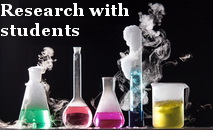Home / Research with students /
10/08/2018
Removal of a textile dye from aqueous solution by eggshell biosorption
Student: Eszter Rápó, MSc, 2nd year
Scientific advisor: Szende Tonk, PhD, Assistant Professor
Water pollution is one of the most important environmental issues of our days, urging us to find a solution as soon as possible. According to several UNICEF and WHO studies, one out of ten people have no access to clean water. Dyes greatly influence the photosynthetic activity in the aquatic environment, while the majority of them also are carcinogenic, mutagenic and toxic to organisms. Synthetic dyes are widely used in textile and printing industries, in laboratories for various chemical processes, and even for surface water tracing. In 2014 more than 1.5 million tons of dyes were produced.
We studied the removal of different dyes (Eriochrom Black T, Methylen Blue, Malachit Green, Congo Red, Bromphenol Blue, Remazol Brilliant Violet-5R) from water by bioremediation methods such as phytoremediation based on two invasive aquatic plants (Eichhornia crassipes (Martius) Solms and Salvinia natans (Linnaeus) Allioni) and adsorption under static conditions with eggshells (Gallus Gallus domesticus) in three forms (untreated-different particle size, calcined and alginate-embedded pearls). In order to characterize the bioremediation we performed various analytical examinations (EDX, SEM, FTIR, Raman spectroscopy), optimal experimental parameters were determined (both through experiment and by neural network models), ecotoxicological studies were performed, the response of water plants to toxic stress was studied (variation in time of the dye concentrations, binding mechanism, changes in photosynthetic pigments, EDX, SEM, stress proteins), and also the photolytic degradation and photocatalytic decomposition of the dyes were carried out.
Our results demonstrate that bioremediation methods can be used to remove dyes from aqueous solutions.










